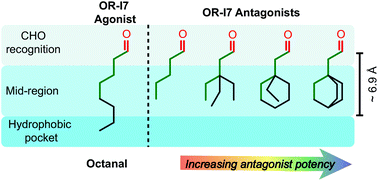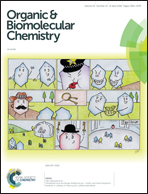Carbon chain shape selectivity by the mouse olfactory receptor OR-I7†
Abstract
The rodent OR-I7 is an olfactory receptor exemplar activated by aliphatic aldehydes such as octanal. Normal alkanals shorter than heptanal bind OR-I7 without activating it and hence function as antagonists in vitro. We report a series of aldehydes designed to probe the structural requirements for aliphatic ligand chains too short to meet the minimum approximate 6.9 Å length requirement for receptor activation. Experiments using recombinant mouse OR-I7 expressed in heterologous cells show that in the context of short aldehyde antagonists, OR-I7 prefers binding aliphatic chains without branches, though a single methyl on carbon-3 is permitted. The receptor can accommodate a surprisingly large number of carbons (e.g. ten in adamantyl) as long as the carbons are part of a conformationally constrained ring system. A rhodopsin-based homology model of mouse OR-I7 docked with the new antagonists suggests that small alkyl branches on the alkyl chain sterically interfere with the hydrophobic residues lining the binding site, but branch carbons can be accommodated when tied back into a compact ring system like the adamantyl and bicyclo[2.2.2]octyl systems.



 Please wait while we load your content...
Please wait while we load your content...